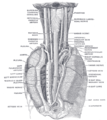Functions of the esophagus
Food is passed through the esophagus by using the process of peristalsis. Specifically, it connects the pharynx, which is the body cavity that is common to the digestive factory and respiratory system with the stomach, where the second stage of digestion is initiated.
The esophagus is lined with mucous membrane, and is more deeply lined with muscle that acts with peristaltic action to move swallowed food down to the stomach.
Histology
The layers of the esophagus are as follows:
- mucosa
- nonkeratinized stratified squamous epithelium: is rapidly turned over, and serves a protective effect due to the high volume transit of food, saliva and mucus.
- lamina propria: sparse.
- muscularis mucosae: smooth muscle
- submucosa: Contains the mucous secreting glands (esophageal glands), and connective structures termed papillae.
- muscularis externa (or "muscularis propria"): composition varies in different parts of the esophagus, to correspond with the conscious control over swallowin g in the upper portions and the autonomic control in the lower portions:
- upper third, or superior part: striated muscle
- middle third, smooth muscle and striated muscle,
- inferior third: predominantly smooth muscle.
- adventitia
Gastroesophageal junction
The junction between the esophagus and the stomach (the gastroesophageal junction or GE junction) is not actually considered a valve, although it is sometimes called the cardiac sphincter, cardia or cardias, but is actually more of a stricture.


























No comments:
Post a Comment